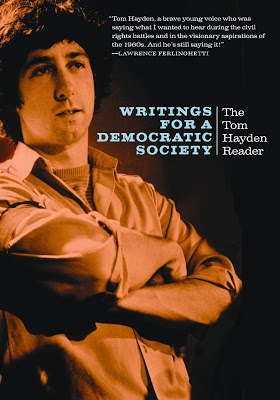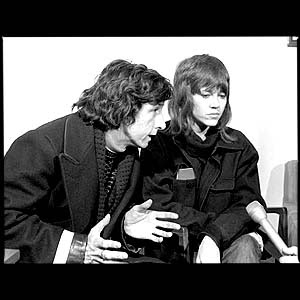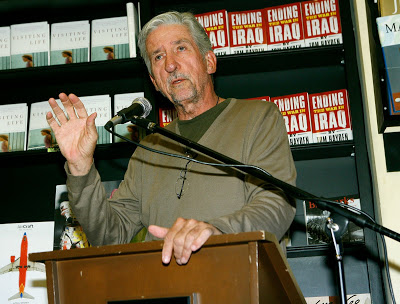
Richard Flacks discusses Tom Hayden
and the new collection of his writings
By Richard Flacks / June 12, 2008
If you were on the campus at Ann Arbor at the dawn of the 1960s, you’d have been aware of Tom Hayden’s writings in The Michigan Daily (the substantial and influential University of Michigan student newspaper). He first came to notice for his travels to the South to cover scenes of civil rights struggle and the movement then bursting into history. Then during the summer of 1960, Hayden was reporting from California, on the new breed of student rebel at Berkeley, on farmworker conditions in Delano, and a conversation with Edward Teller, the father of the H-bomb, at the Livermore Nuclear Lab. And then there was Hayden at the Democratic National Convention in Los Angeles, watching JFK’s nomination and interviewing Martin Luther King Jr. as he led pickets in the streets outside the convention arena. In the fall of 1960, Hayden became editor in chief of the Daily, writing full-page articles declaring the birth of an American student movement. He was 20 that year.
Mickey and I, just married, were in Ann Arbor, where I was working toward a Ph.D. in social psychology. We’d gone there from New York City, both of us red diaper babies, disillusioned with communism’s betrayals, harboring no expectations that we’d ever find a way to restore political hope, enjoying instead our breakaway from the provincialism of the City, and discovering at that moment cultural possibilities unknown to New Yorkers. Ann Arbor was humming with film and electronic music festivals, “happenings,” coffeehouses and bookstores where young writers and artists could find voice and space that would not have been possible in the big city. Tom Hayden’s articles in the Daily became part of that ferment. We read them avidly, seeing them not as mere reportage, but as an effort to construct an exciting political myth—that Cold War apathy and conformism might be replaced by a new, youthful protest and dissent, spawned by the civil-rights movement, seeking possibilities for personal commitment and social renewal. We weren’t yet ready to believe his story line, but we certainly wanted to hear it.
In March 1962, Hayden delivered a well-advertised speech at the university on “student social action.” That speech changed my life: Here was a 21-year-old kid from America’s heartland, putting into words what Mickey and I had been groping and hoping for—that in the United States a new left was needed and possible, that it had to break with many of the fundamental suppositions of all the factions of the traditional left and with Cold War America, that it could come in part from students. He quite insightfully saw how personal struggles for individual self-determination and moral coherence could fuel a collective commitment of youth to social change. I remember coming home right after the speech and telling Mickey: “I think I’ve just seen the American Lenin!” This wasn’t a reference to the substance of Hayden’s talk, which was quite self-consciously antithetical to Marxist-Leninist doctrine, but to his evident gift for making the hope for a movement seem a practical possibility.
Hayden’s speech that day was a trial run for what became, by the summer of 1962, a fuller draft of a manifesto for the emerging Students for a Democratic Society. Sixty folks, including Mickey and me, gathered in Port Huron, Mich., in June to debate and rework the draft and lay the groundwork for what was meant to be, and eventually became, the organizational expression of the 1960s’ new left, and the spearhead of a multi-issue student movement. Tom Hayden wasn’t the originator of this breakthrough (if any single person deserves credit, it’s Al Haber—a fellow Ann Arborite, who actually created SDS out of the remnants of the old Student League for Industrial Democracy and recruited Tom and other student leaders to the project). But Tom’s writing and speaking enabled a genuinely new political voice and outlook to come into being. He was, appropriately enough, elected first president of the new formation at that meeting.
Forty-five years later, City Lights, the independent press founded by Lawrence Ferlinghetti, has published a collection of Hayden’s writings over the last nearly five decades, called “Writings for a Democratic Society: The Tom Hayden Reader.” Its 600 pages [in one edition] make it a monumental book in more ways than one. It’s fat and densely packed, with some 60 pieces of reportage, advocacy, reminiscence and reflection drawn from some of the more than 15 books Hayden has written or edited, and the hundreds of articles and speeches he’s produced over these years. (Full disclosure: Not only have I been a friend of his for the last 47 years, but I discovered, after getting the galleys, that one of the chapters is a speech Tom gave in my honor two years ago. But what I write here is not a “review”; rather, it uses the occasion of this book to reflect a bit about Tom’s work in helping advance radical democracy in our time.)
It isn’t the size of the book that makes it monumental; it’s the life that has gone into the writing and that is reflected by it. The book’s chapters trace that life: from student journalist to SDS leader to community organizer in the Newark ghetto; then on to North Vietnam in the midst of war, to Chicago streets leading anti-war protest, to Chicago courtroom as a defendant in the conspiracy trial. Then his partnering with Jane Fonda in working to end the war and in life. In the mid-1970s, seizing new mainstream political openings, running for the U.S. Senate in California, building a statewide electoral organization, winning a seat in the California Legislature. In the state Legislature, where he serves for 20 years, he pioneers alternative energy development and, along the way, crafts a spiritual perspective on environmentalism, discovers his Irish heart, and tries to rouse the University of California to serve egalitarian purposes.
And, after he ends his adventures as politician, we find him in the streets of Seattle and Miami, in Mumbai and Chiapas, in Bolivia and Cuba exploring and reporting newly emerging movements for global justice. Not many Americans have done so much making of history while, at every juncture, taking the time to be a “participant observer” of the scenes and events one is helping to shape. The writings so produced are of course uneven in style and perspicacity. Some are remarkably moving and insightful: a heartfelt reflection on the meanings of the Irish famine for the American Irish soul; some brilliant appreciations of the meaning of the World Social Forum and other grass-roots resistances to corporate globalization; a weird “journal” of epiphany in the Amazon, and a number of valuable documents and reflections on the meanings of the 1960s, both personal and political. These suggest that Tom Hayden could have been one of the great journalists of our time, given his ability to combine a penetrating style, keen eye and an unusually sharp theoretically informed mind.
Tom, however, chose a different path—to change the world rather than merely interpret it. From those early Ann Arbor days, he insisted on living inside the fierce contradictions and dilemmas inherent in political engagement. Engagement demands advocacy, and therefore at least some sacrifice of the intellectual’s claim to being a disinterested truth-seeker. Accordingly, these “Writings” don’t tell stories or express ideas for their own sake; each of them is making a point in an ongoing debate with the powers that be and reflects a persistent effort to challenge the complacent and the passive.
But some of these pieces are deeper and more durable than topical advocacy. Tom has had, from his earliest work, something to teach both activists and intellectuals about the tensions and connections between them. He’s been guided by a fairly coherent philosophical pragmatism, learned from his Michigan professors like Arnold Kaufman and Kenneth Boulding, from immersion in the writings of C. Wright Mills, as well as now neglected heroes of the late ’50s and early ’60s Albert Camus and Paul Goodman. Our passion and our action, this pragmatism says, should be guided by our experience, rather than ideological doctrine, theory or concealed thirst for power. Here, Tom suggests, are some ways to make our experience useful for making change:
* Take institutional claims seriously and see if they are practiced by those in power.
* Challenge elites to live up to their claims, to justify their actions.
* Oppose structures of authority that block ordinary people from, in the language of Port Huron, “participating in the decisions that affect their lives.”
* Try to figure out, by observation of relevant cases, by experimentation, by dialogue, how social empowerment and participatory democracy can be made real.
It is through such ongoing efforts to organize from below, to win voice for the voiceless, to de-legitimize elites, that fundamental change happens. And, he teaches, whether or not transformation is possible, that struggling for democratic voice and empowerment is the essence of practical strategies by which ordinary people can advance their interests.
In 1976, at age 36, Tom made a turn to electoral politics after 15 years as a movement leader. He decided to run in the California Democratic Party primary for U.S. Senate, opposing the incumbent John Tunney. Not only was this a break with his longstanding political identity, but it was an affront to the interests and sensibilities of party professionals. Running for the Senate was presumptuous for a political upstart, it threatened a perfectly respectable liberal incumbent, and it was bizarre to imagine that a former revolutionary ex-Chicago conspiracy defendant, spouse of Jane Fonda, might have a chance in the political mainstream. The move was also questioned by many on the left—as an opportunistic betrayal of principle which would legitimize one of the two corporate-dominated political parties and undermine the effort to build a mass movement.
Tom’s pragmatism, however, allowed him to see that the mid-1970s might be a moment when the electoral process could be open for a genuinely democratic possibility. The generation of the 1960s was now grown up and ready to be an electoral force (“The radicalism of the sixties is the common sense of the seventies,” he declared). The economy was in stagflation (and the Keynesian strategies to revive it seemed no longer viable). Rising global competition in manufacturing was leading to declining real wages for American workers for the first time since World War II. A new awareness of environmental peril was rising; newly asserted demands for economic justice were being expressed by women and minorities. In Europe and the United States speculation was growing that corporate capitalism was in crisis, no longer able to manage its manifold contradictions. New paradigms were in the air: “Eurosocialism” and “Eurocommunism,” Ralph Nader’s crusade against corporate domination, and a variety of ideas about how to empower communities, workers and consumers. Tom’s campaign decided to issue a new Port Huron Statement-style manifesto, and gathered a number of academics and activists, myself among them, to write a campaign platform which we called “Make the Future Ours.” Some passages from this lengthy effort are reprinted in the “Writings.” The key idea was captured by the phrase “economic democracy,” coined by Derek Shearer, a term that paralleled and focused the “participatory democracy” of SDS at Port Huron.
In reality, however, the Hayden for Senate campaign did not operate as a vehicle for new vision. Instead the logic of big-time campaigning—and the availability of Jane Fonda as effective fundraiser—led to a series of negative TV ads aimed at Tunney’s vulnerabilities, featuring Henry Fonda and other Hollywood figures. These ads boosted Hayden’s poll numbers into the 40 percent approval range. In addition, there was a sizable grass-roots organization, and Tom undertook a 1,000-mile walk down the California coast. To win the race was always a long shot, but garnering 1.3 million votes led the media to take Hayden seriously as leader of something new on the political scene.
An internal premise of key organizers was that the campaign, when it was over, would be the foundation for a permanent progressive electoral organization in California, and within a few weeks after the June primary race, the “Campaign for Economic Democracy” came into being. The CED became a significant electoral force in several cities and counties over about five years. It came to an end as Tom focused on his own political career, getting elected from Santa Monica to the California state Assembly, while many other CED activists found niches in government, party politics and mass media.
This chapter in Tom’s life story is not well represented in the book, nor does he devote much space to the 20 years he spent in the California Legislature. This absence reflects the fact that he hasn’t written much about these matters. The CED’s work and his efforts in the Legislature certainly bore fruit of which he’s proud (and these are mentioned in the text of the book). But to write in detail about these efforts, and the times themselves, might also be painful. The hope that many new leftists had, in the 1970s, of creating a new movement for economic democracy was considerably dashed by the rise of Reagan and the triumph of conservatism on the national stage.
The fact that such a hope existed has been largely obliterated in prevailing memory, and there has not been much documentation of the fact that as national politics moved right in the last 30 years, many localities across the country were moving left. Politics rooted in environmentalism, feminism and the growing numbers of Latino and Asian-American voters have changed local structures of power and implemented some pieces of the “economic democracy” agenda. (The Web site http://www.community-wealth.org/ provides a comprehensive inventory of local efforts at establishing economic democracy.) Below the radar, new forms of citizen action have taken local power away from old local elites. In Santa Barbara, where we’ve lived for 40 years, local government, once securely controlled by bankers and real estate agents, now is led by environmentalists, feminists and liberal Democrats. It’s a shift that’s happened in many other California communities, too. These developments need to be documented, in part because they constitute some of the experience that a new national reform agenda can draw on.
Tom is now 68, and some of us of the SDS generation are in our 70s. It would be a good thing if, individually and collectively, members of that generation were to spend some part of their remaining years in efforts to closely interrogate our political experience. I don’t mean producing further rehashings of “The 1960s.” It’s the 40 years since then that have been inadequately examined. Tom Hayden and his compatriots helped shape the history of these decades, and not always in ways we intended. Still, it’s the right that claims and is generally perceived to have dominated during most of this time. Yet all ideological perspectives from left to right have failed to comprehend the world as we now experience it. An effort to comprehend the state of that world would benefit from a systematic examination of the gap between the expectations and hopes of activists on all sides and the reality that ensued.
But ’60s oldsters now are stirring themselves to new action rather than reflection. Tom Hayden himself has been tirelessly speaking, writing and organizing in hope of mobilizing grass-roots opposition to the war in Iraq. Some of the pieces in “Writings” express his excitement on encountering the street-level global justice movement. He and other ’60s veterans are even more excited by the Barack Obama youth surge. It inspires hope for social regeneration in some of the ways the youth revolt of the 1960s offered.
Hillary Clinton wasn’t, as far as I know, an SDS member back in the day, but we do know that she was moved by the student movement and the new left. Yet it is Obama, (even though, as he has reminded us, he was only 7 years old in 1968), whose campaign provides validation for some of the hopes of the new left. He, like Tom Hayden, roots his leadership experience in his work as a community organizer. His campaign, as explained by Michelle Obama, bears a striking resemblance to the way Hayden’s 1976 Senate campaign was conceived. She declared: “Barack is not a politician first and foremost. He’s a community activist exploring the viability of politics to make change.” Obama’s frequent assertion that it’s not the president who makes change, it’s the movement from the bottom up that makes change, very much expresses the spirit of the “organizing tradition” that includes SNCC, SDS, King, Saul Alinsky and the “local heroes” who led the movements of the 1960s. Maybe participation in and critical observation of the Obama experiment will provide the best opportunity we’ve had to learn about the chances for that democratic society Tom and his co-conspirators started to write and organize for in the very year that Obama was born.
Richard Flacks is professor of sociology emeritus at the University of California, Santa Barbara, where he has taught since 1969. He is the author of “Making History: The American Left and the American Mind,” published by Columbia University Press.
Source. / Truthdig
Find Tom Hayden’s Writings for a Democratic Society on Amazon.com.
The Rag Blog



















